Rule Study on the Risk of Floor Water Inrush Based on the Plate Model Theory
Abstract
1. Introduction
2. Methods
2.1. Plate Model Theoretical Analysis
2.2. Control Equations
2.2.1. Controlling Equations for Solid Mechanics
2.2.2. Control Equations for Seepage Mechanics
2.2.3. Coupling Equations
2.3. Control Equations
3. Results
3.1. Influence of Mining Distance on Damage to the Bottom Slab
3.2. The Influence of Water Pressure on the Damage of the Bottom Plate
3.3. Distribution Law of Stress
4. Discussion
5. Conclusions
- (1)
- Simplifying the water-resistant layer beneath the bottom plate as a rectangular thin plate with four-side fixed support is feasible for study as reported in references [23,24,25,26,27,28,29,30,31]. Supported by the actual working conditions of the 4103 working face in the Heshan coal mine, the theoretical formulae for the maximum span, maximum water pressure, and peak position of the bending moment were derived through thin plate mechanics. The results of the fluid-solid coupling analysis in the COMSOL Multiphysics software showed that the bottom plate rock mass exhibited different degrees of damage and that the damage tended to occur at the center of the bottom plate under different water head pressures and mining distances. During the dynamic mining process of coal seam, the vertical stress was concentrated in the center positions of the cutting eye, stop line, and coal wall. The results of the two methods were highly consistent, and further accurately predicted the risk of water inrush from the bottom plate in the coal mining face
- (2)
- Combining the relationship between stress and deflection function in the theory of elasticity, the deflection surface of the four-sided fixed thin plate under the influence of mining distance of 200 m, 300 m, and water pressure of 1 MPa, 2 MPa, 3 MPa is plotted using Matlab software. By analyzing the results, it is found that when the deflection of the four-sided fixed plate exceeds 0.15 m, the central position of the bottom plate, the stopping line, and the center of both sides of the coal wall are prone to water inrush. Under the same water pressure, the increase in mining distance has a greater impact on the maximum deflection of the fixed plate, indicating that under the same conditions, the increase in mining distance causes more damage to the bottom plate.
- (3)
- Based on the actual production situation of the 4103 working faces in Heshan mine, the method of using the elastic-plastic theory to simplify the waterproof layer of its bottom plate as a thin plate subjected to uniformly distributed loads on all sides for mechanical analysis and numerical simulation is feasible and can effectively predict the danger of bottom water inrush of the coal mining face, which provides great safety assurance for coal mine operation.
Author Contributions
Funding
Institutional Review Board Statement
Informed Consent Statement
Data Availability Statement
Conflicts of Interest
Nomenclature
| ω | deflection |
| a | the long side length of the plate |
| b | the length of the short side of the plate |
| Cm | undetermined coefficient |
| m | positive integer |
| ∇4 | laplacian |
| Mx, My | bending moment |
| h2 | the thickness of the water barrier layer |
| αt | ultimate tensile strength |
| D | flexural rigidity |
| q | theoretical load |
| E | rock elastic modulus |
| ν | poisson ratio |
| G | shear modulus |
| ui | offset component |
| Fi | body force component |
| α | Biot’s coefficient |
| p | pore water pressure |
| K | the permeability coefficient of rock mass |
| γw | the gravity of the fluid |
| z | vertical direction coordinates |
| Qs | quality source items |
| fc0 | single axis compressive strength |
| φ | the angle of internal friction |
| σ1 | maximum principal stress |
| σ3 | minimum principal stress |
| D1 | damage variable |
| εt0 | maximum circumferential strain |
| εc0 | maximum compressive strain |
| ε1 | maximum principal strain |
| ε3 | Minimum principal strain |
| n | damage evolution coefficient |
| ϕ0 | the porosity of rock mass under the initial stress state |
| ϕr | the limit value of rock porosity under high-pressure stress |
| αϕ | stress sensitivity coefficient. |
| mean effective stress | |
| K0 | permeability coefficient under the initial stress state |
| αk | influence coefficient of damage on the permeability coefficient |
References
- Brücker, C.; Preuße, A. The future of underground spatial planning and the resulting potential risks from the point of view of mining subsidence engineering. Int. J. Min. Sci. Technol. 2020, 30, 93–98. [Google Scholar] [CrossRef]
- Su, F.-q.; Itakura, K.-i.; Deguchi, G.; Ohga, K. Monitoring of coal fracturing in underground coal gasification by acoustic emission techniques. Appl. Energy 2017, 189, 142–156. [Google Scholar] [CrossRef]
- Wang, J.; Dong, Y.; Wu, J.; Mu, R.; Jiang, H. Coal production forecast and low carbon policies in China. Energy Policy 2011, 39, 5970–5979. [Google Scholar] [CrossRef]
- Guo, F.; Jiang, G.; Yuan, D.; Polk, J.S. Evolution of major environmental geological problems in karst areas of Southwestern China. Environ. Earth Sci. 2013, 69, 2427–2435. [Google Scholar] [CrossRef]
- Fan, K.; Li, W.; Wang, Q.; Liu, S.; Xue, S.; Xie, C.; Wang, Z. Formation mechanism and prediction method of water inrush from separated layers within coal seam mining: A case study in the Shilawusu mining area, China. Eng. Fail. Anal. 2019, 103, 158–172. [Google Scholar] [CrossRef]
- Hebblewhite, B. Fracturing, caving propagation and influence of mining on groundwater above longwall panels–a review of predictive models. Int. J. Min. Sci. Technol. 2020, 30, 49–54. [Google Scholar] [CrossRef]
- Hou, X.; Shi, W.; Yang, T. A non-linear flow model for the flow behavior of water inrush induced by the karst collapse column. RSC Adv. 2018, 8, 1656–1665. [Google Scholar] [CrossRef]
- Huang, Z.; Zeng, W.; Zhao, K. Experimental investigation of the variations in hydraulic properties of a fault zone in Western Shandong, China. J. Hydrol. 2019, 574, 822–835. [Google Scholar] [CrossRef]
- Li, P. Mine Water Problems and Solutions in China. Mine Water Environ. 2018, 37, 217–221. [Google Scholar] [CrossRef]
- Li, S.; Ma, C.; Liu, R.; Chen, M.; Yan, J.; Wang, Z.; Duan, S.; Zhang, H. Super-absorbent swellable polymer as grouting material for treatment of karst water inrush. Int. J. Min. Sci. Technol. 2021, 31, 753–763. [Google Scholar] [CrossRef]
- Ma, D.; Duan, H.; Zhang, J.; Bai, H. A state-of-the-art review on rock seepage mechanism of water inrush disaster in coal mines. Int. J. Coal Sci. Technol. 2022, 9, 50. [Google Scholar] [CrossRef]
- Ma, D.; Wang, J.; Li, Z. Effect of particle erosion on mining-induced water inrush hazard of karst collapse pillar. Environ. Sci. Pollut. Res. 2019, 26, 19719–19728. [Google Scholar] [CrossRef] [PubMed]
- Sun, W.; Zhou, W.; Jiao, J. Hydrogeological Classification and Water Inrush Accidents in China’s Coal Mines. Mine Water Environ. 2016, 35, 214–220. [Google Scholar] [CrossRef]
- Xing, M.; Li, W.; Wang, Q.; Yang, D. Risk prediction of roof bed-separation water inrush in a coal mine. China. Electron. J. Geotech. Eng. 2015, 20, 301–312. [Google Scholar]
- Bi, Y.; Wu, J.; Zhai, X. Quantitative prediction model of water inrush quantities from coal mine roofs based on multi-factor analysis. Environ. Earth Sci. 2022, 81, 314. [Google Scholar] [CrossRef]
- Dong, S.; Wang, H.; Guo, X.; Zhou, Z. Characteristics of Water Hazards in China’s Coal Mines: A Review. Mine Water Environ. 2021, 40, 325–333. [Google Scholar] [CrossRef]
- Sun, W.; Liu, H.; Cao, Z.; Yang, H.; Li, J. Mechanism Analysis of Floor Water Inrush Based on Criteria Importance though Intercrieria Correlation. Water 2023, 15, 232. [Google Scholar] [CrossRef]
- Yin, H.; Zhou, W.; LaMoreaux, J.W. Water inrush conceptual site models for coal mines of China. Environ. Earth Sci. 2018, 77, 746. [Google Scholar] [CrossRef]
- Zhou, X.-P.; Wang, Y.-T.; Shou, Y.-D. Hydromechanical bond-based peridynamic model for pressurized and fluid-driven fracturing processes in fissured porous rocks. Int. J. Rock Mech. Min. Sci. 2020, 132, 104383. [Google Scholar] [CrossRef]
- Huang, C.; Dong, W.; Cao, Z.; Wang, Y.; An, G.; Chen, H.; Jia, Y.; Pan, Q. Water Inrush Mechanism of Fault Zone in Karst Tunnel under Fluid-Solid Coupling Field considering Effective Stress. Geofluids 2022, 2022, 4205174. [Google Scholar] [CrossRef]
- Song, W.; Liang, Z. Theoretical and numerical investigations on mining-induced fault activation and groundwater outburst of coal seam floor. Bull. Eng. Geol. Environ. 2021, 80, 5757–5768. [Google Scholar] [CrossRef]
- Zhang, S.; Guo, W.; Li, Y.; Sun, W.; Yin, D. Experimental simulation of fault water inrush channel evolution in a coal mine floor. Mine Water Environ. 2017, 36, 443–451. [Google Scholar] [CrossRef]
- Li, Q.; Meng, X.; Liu, Y. Sensitivity analysis of water inrush evaluation model based on the theory of water resistant key strata: A case study in a coal mine, China. Earth Sci. Inform. 2022, 15, 2481–2494. [Google Scholar] [CrossRef]
- Liu, S.; Liu, W.; Huo, Z.; Song, W. Early warning information evolution characteristics of water inrush from floor in underground coal mining. Arab. J. Geosci. 2019, 12, 30. [Google Scholar] [CrossRef]
- Sun, J.; Hu, Y.; Zhao, G. Relationship between water inrush from coal seam floors and main roof weighting. Int. J. Min. Sci. Technol. 2017, 27, 873–881. [Google Scholar] [CrossRef]
- Hu, Y.; Liu, W.; Ma, T.; Yang, R.; Liang, D. Analysis on the Stability of the Inclined Water-Resisting Roof Layer While Mining under the Confined Aquifer. Geotech. Geol. Eng. 2019, 37, 995–1006. [Google Scholar] [CrossRef]
- Wang, J.; Xue, Y.; Zhou, M.; Lv, B.; Li, P. Study on Water/mud Inrush of Tunnel Inclined Shaft Based on Material Point Method. IOP Conf. Ser. Earth Environ. Sci. 2020, 570, 022062. [Google Scholar] [CrossRef]
- Wu, L.; Zhang, J.; Wang, Z.; Ma, D.; Wang, G. Research on formation mechanism of the mining-induced horizontal fractures in rock strata separation in the Jurassic coalfield, Huang long, Shaanxi, China. Energy Rep. 2022, 8, 9711–9723. [Google Scholar] [CrossRef]
- Wu, L.; Bai, H.; Ma, D. Prediction and Prevention of Water Inrush Hazards from Bed Separation Space. Mine Water Environ. 2021, 40, 657–670. [Google Scholar] [CrossRef]
- Tang, J.; Bai, H.; Yao, B.; Wu, Y. Theoretical analysis on water-inrush mechanism of concealed collapse pillars in floor. Min. Sci. Technol. 2011, 21, 57–60. [Google Scholar] [CrossRef]
- Sun, J.; Wang, L.G.; Hou, H.Q. Research on water-isolating capacity of the compound water-resisting key strata in coal seam floor. Zhongguo Kuangye Daxue Xuebao/J. China Univ. Min. Technol. 2013, 42, 560–566. [Google Scholar]
- Sun, G.; Zhang, R.; Tian, K. Experimental study of the evolution of permeability in coal containing gas during short-term creep under multi-stage loading. J. Mines Met. Fuels 2018, 66, 414–422. [Google Scholar]
- Zhu, W.C.; Wei, C.H. Numerical simulation on mining-induced water inrushes related to geologic structures using a damage-based hydromechanical model. Environ. Earth Sci. 2011, 62, 43–54. [Google Scholar] [CrossRef]
- Zhu, W.C.; Tang, C.A. Micromechanical Model for Simulating the Fracture Process of Rock. Rock Mech. Rock Eng. 2004, 37, 25–56. [Google Scholar] [CrossRef]
- Rutqvist, J.; Tsang, C.-F. A study of caprock hydromechanical changes associated with CO2-injection into a brine formation. Environ. Geol. 2002, 42, 296–305. [Google Scholar] [CrossRef]
- Li, L.; Yang, T.; Liang, Z.; Zhu, W.; Tang, C. Numerical investigation of groundwater outbursts near faults in underground coal mines. Int. J. Coal Geol. 2011, 85, 276–288. [Google Scholar] [CrossRef]
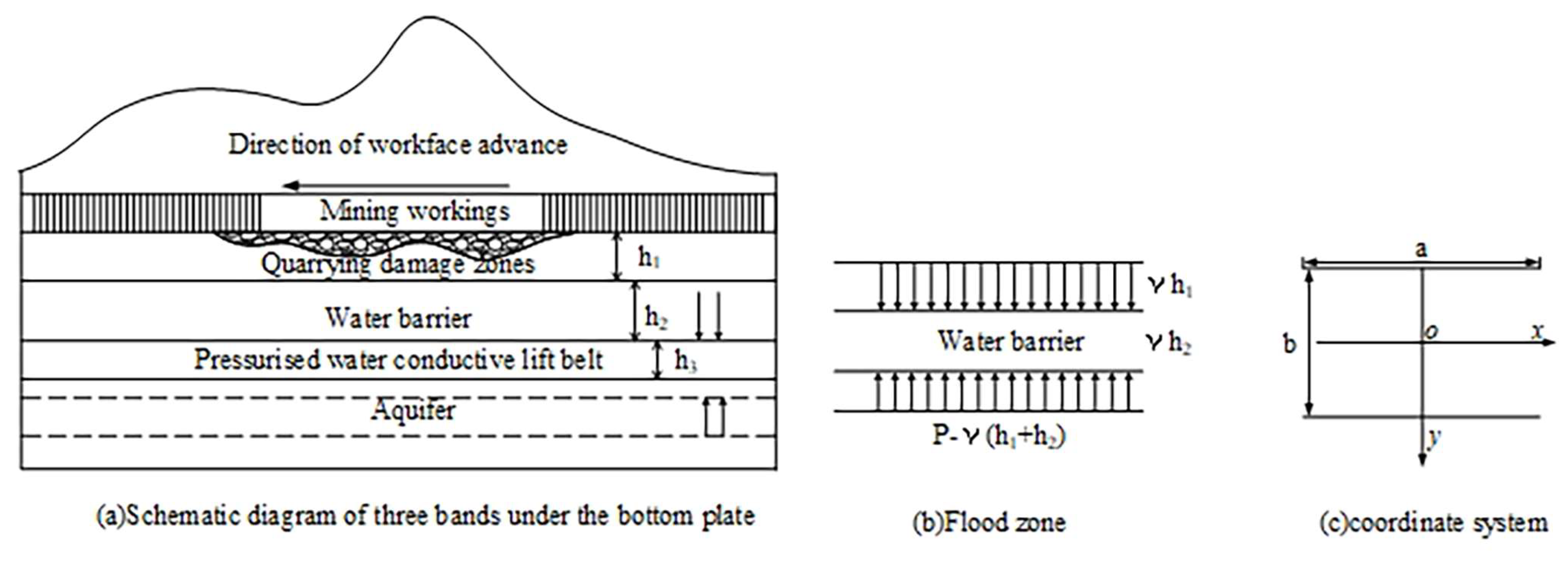
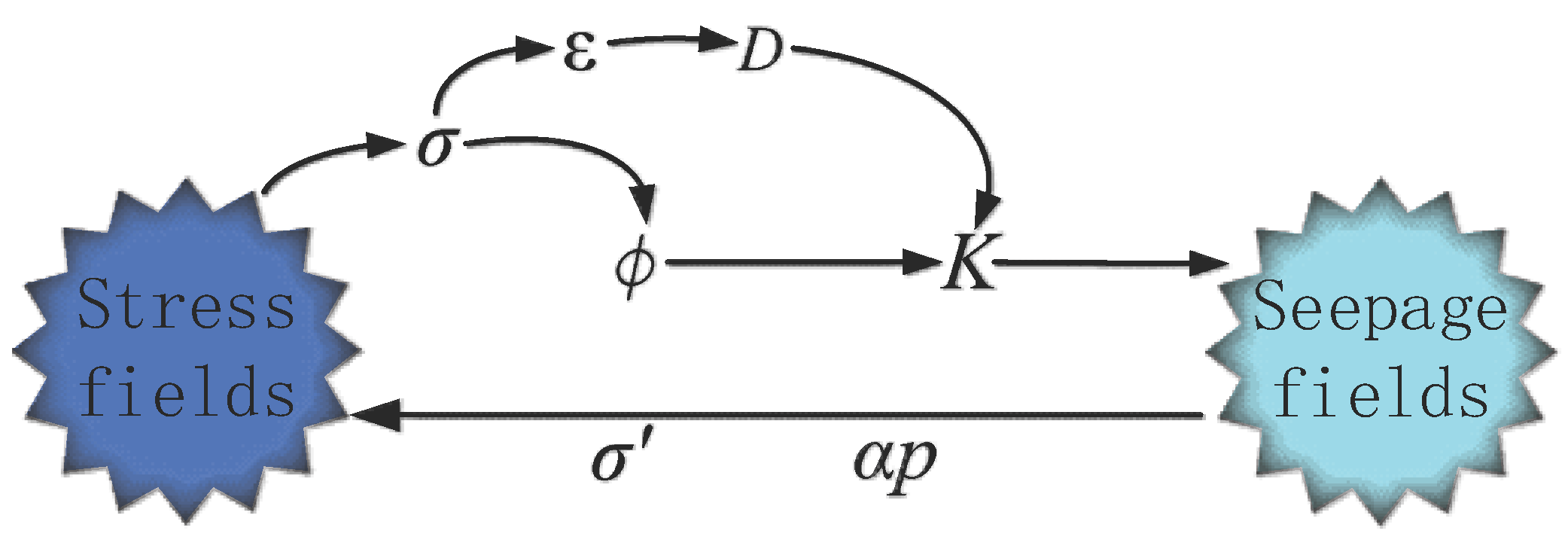
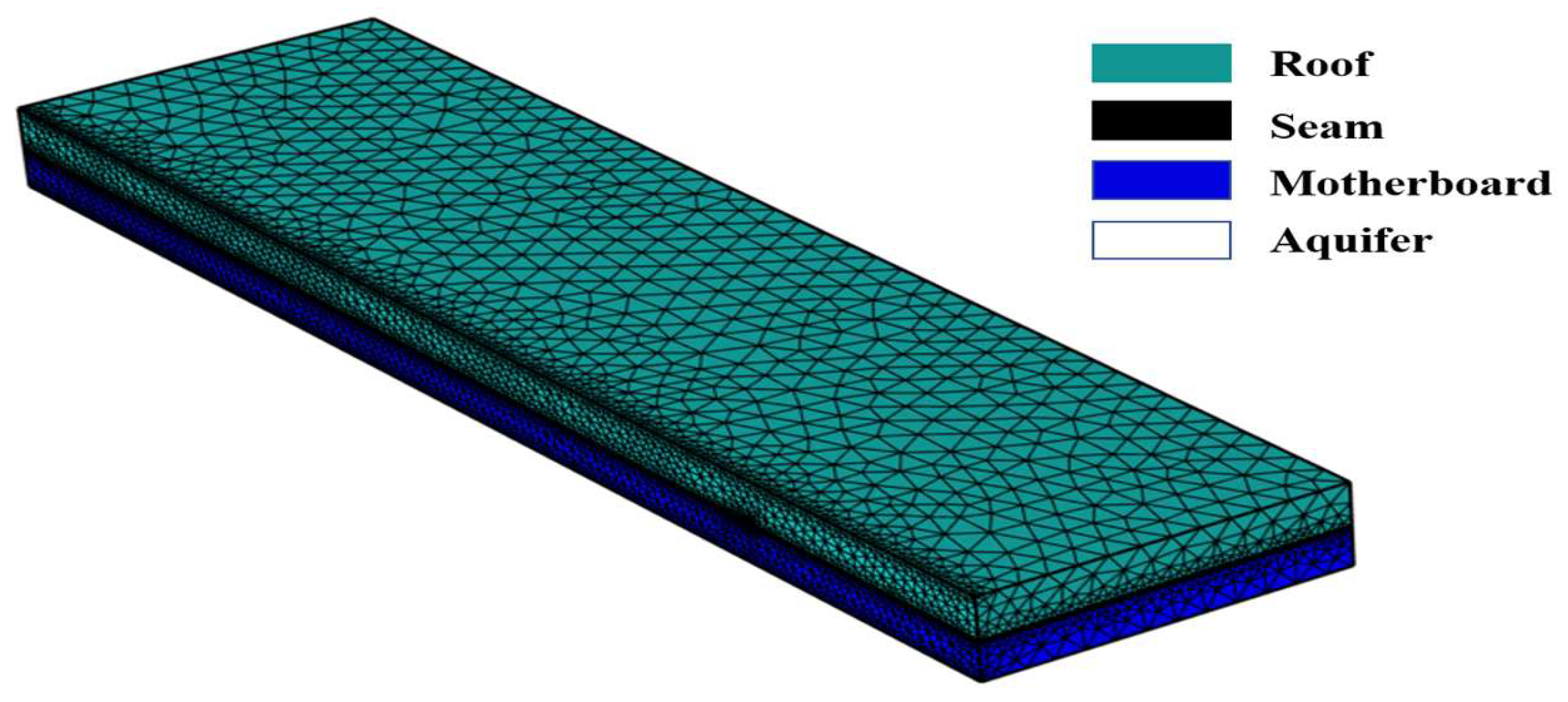


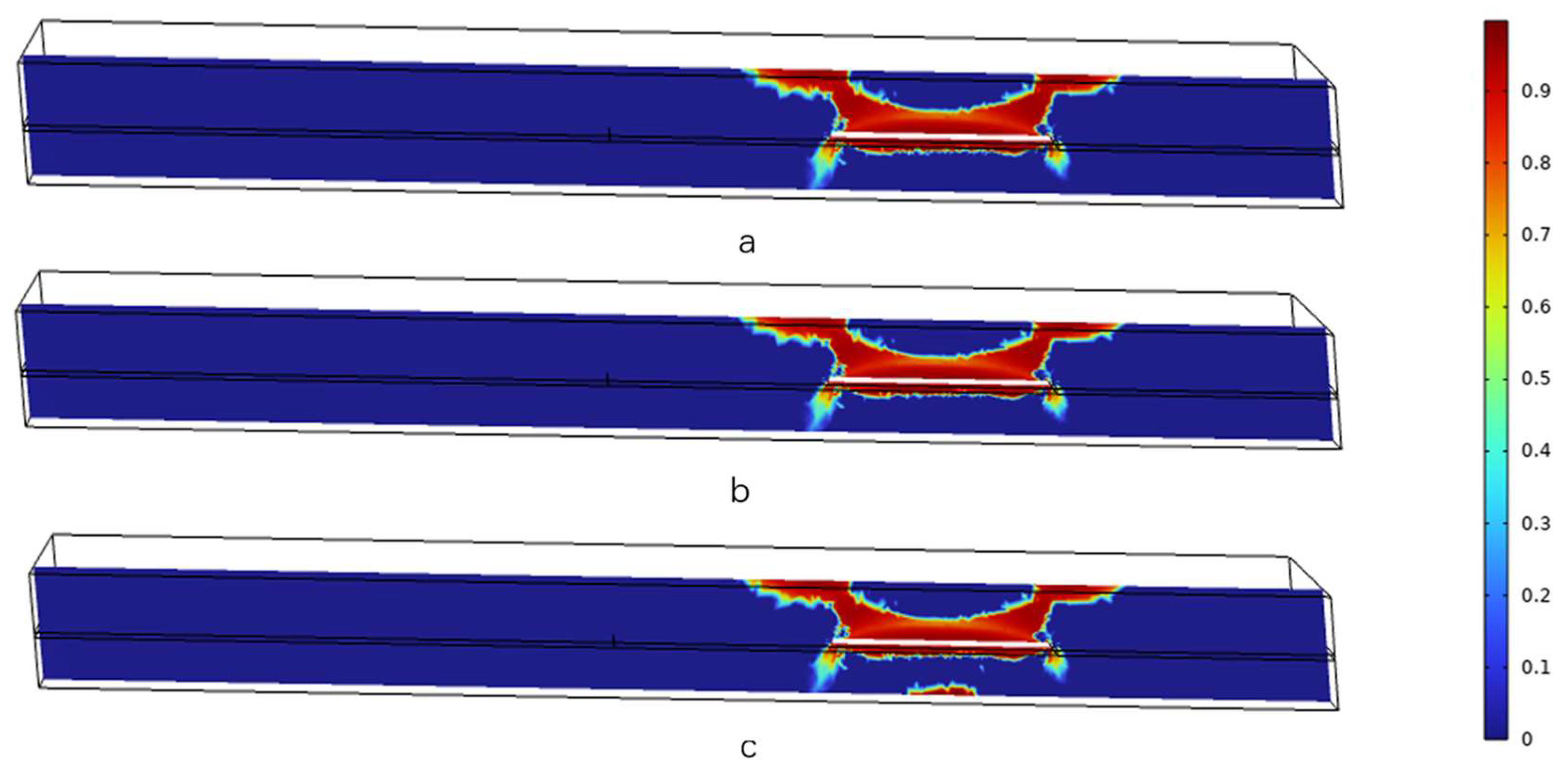

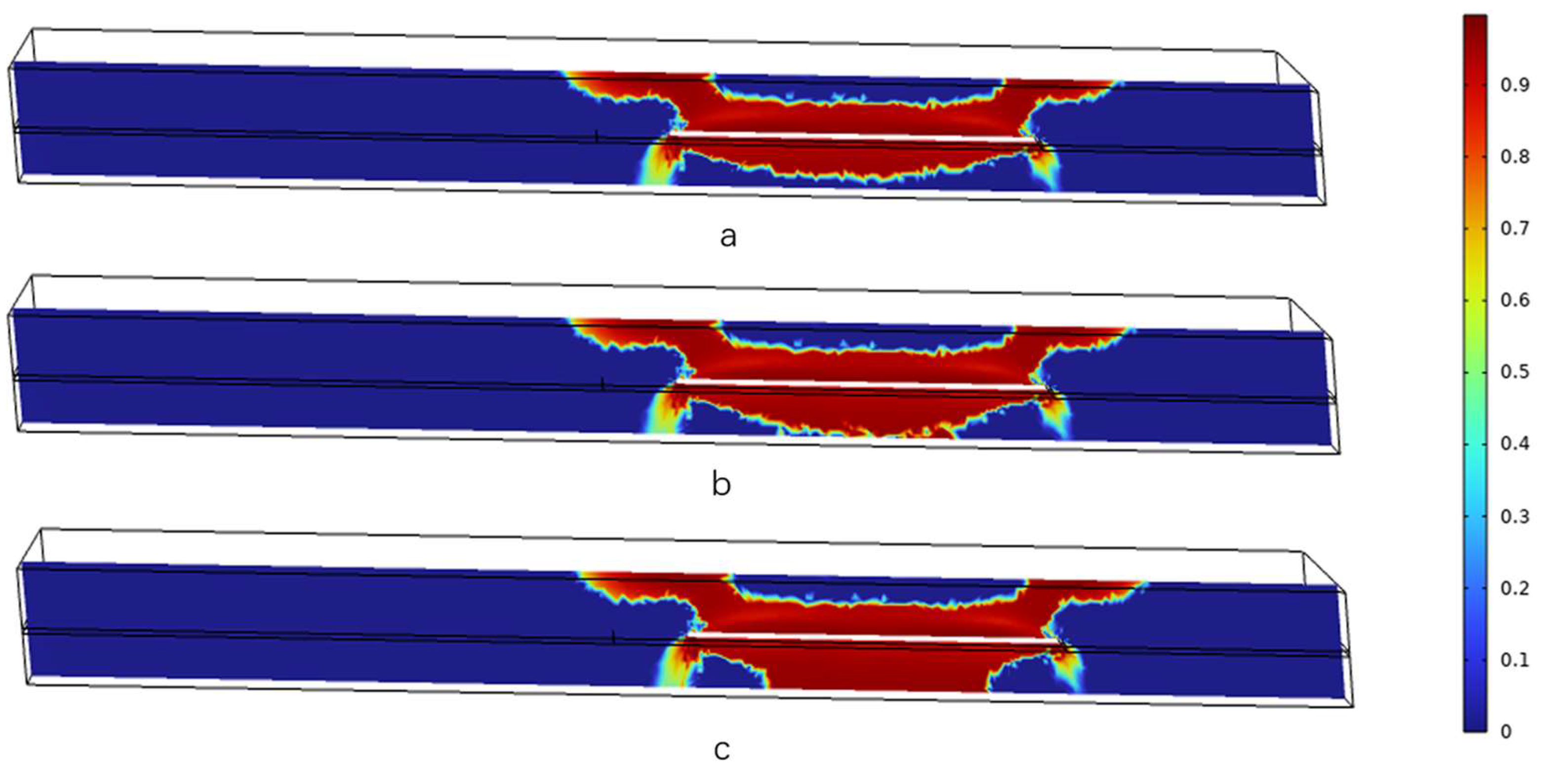
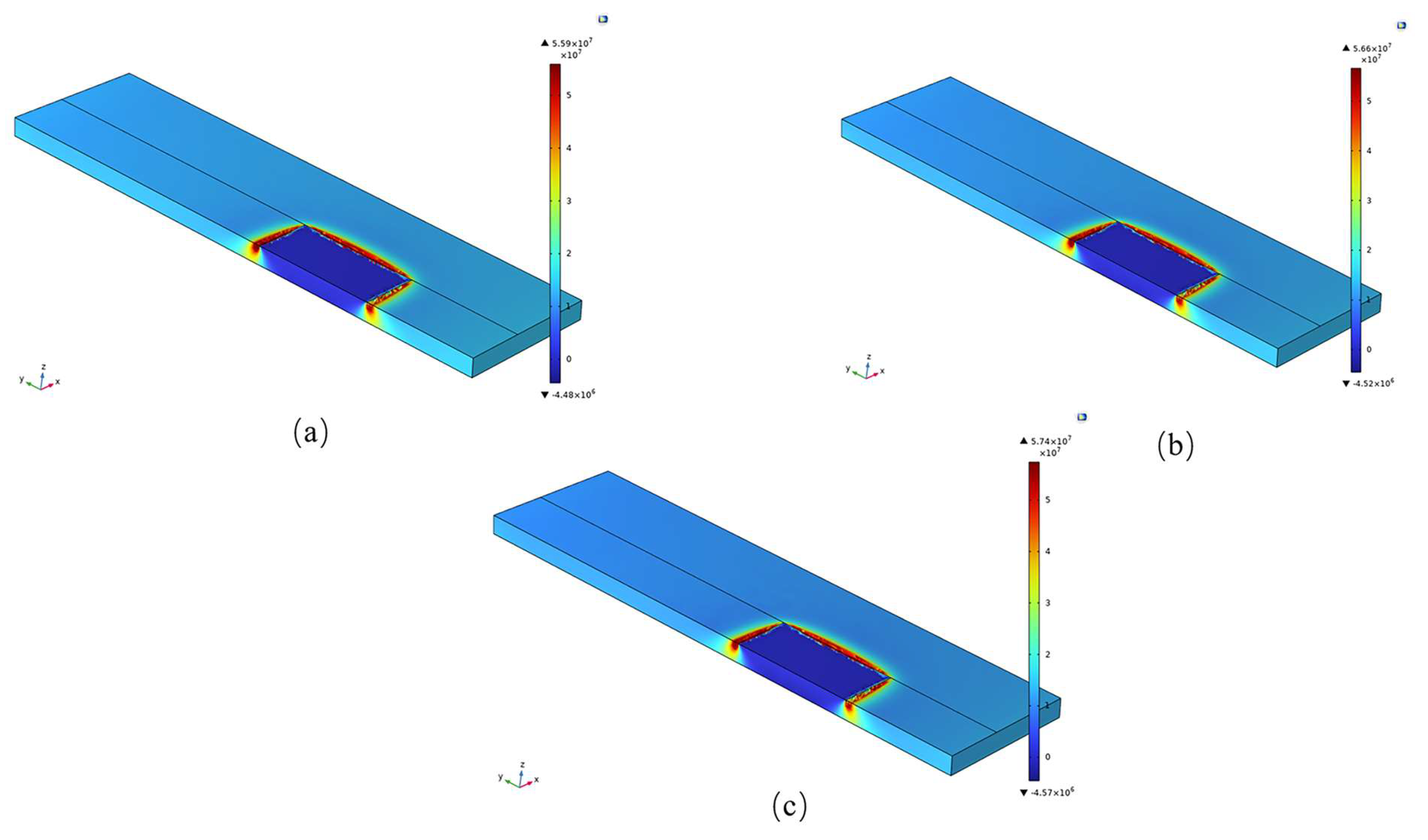
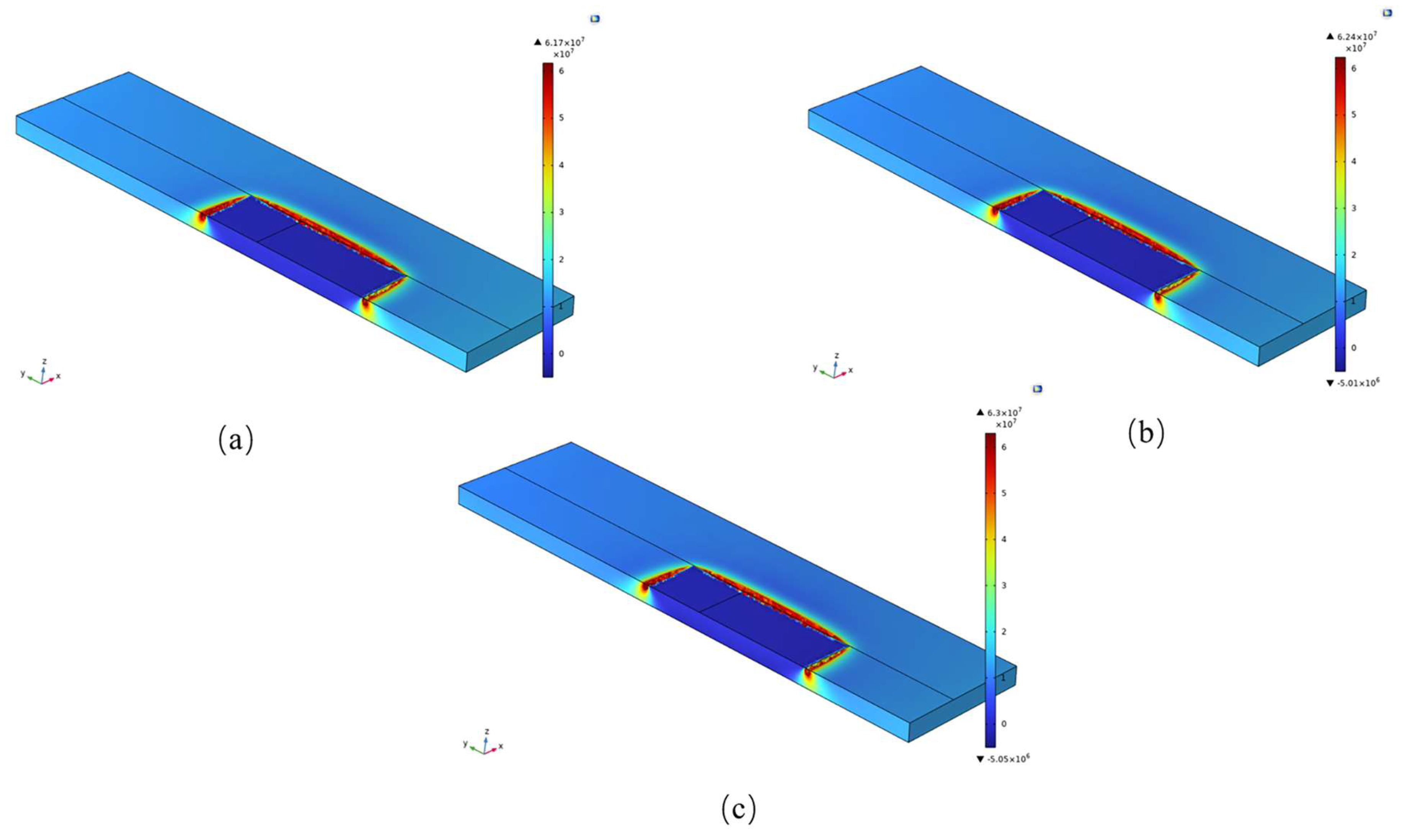



| Rock Formation | Density /(kg/m3) | Elastic Modulus /GPa | Poisson’s Ratio | Cohesion /MPa | Internal Friction Angle /(°) | Tensile Strength /MPa | Permeability Coefficient /(10−8 m/s) | Porosity |
|---|---|---|---|---|---|---|---|---|
| Roof | 2700 | 24 | 0.32 | 8.9 | 28 | 1.9 | 0.89 | 0.009 |
| Coal seam | 1500 | 4 | 0.35 | 1.7 | 36 | 0.2 | 1.9 | 0.12 |
| Bottom plate | 2710 | 23 | 0.26 | 15 | 40 | 2.1 | 0.82 | 0.008 |
Disclaimer/Publisher’s Note: The statements, opinions and data contained in all publications are solely those of the individual author(s) and contributor(s) and not of MDPI and/or the editor(s). MDPI and/or the editor(s) disclaim responsibility for any injury to people or property resulting from any ideas, methods, instructions or products referred to in the content. |
© 2023 by the authors. Licensee MDPI, Basel, Switzerland. This article is an open access article distributed under the terms and conditions of the Creative Commons Attribution (CC BY) license (https://creativecommons.org/licenses/by/4.0/).
Share and Cite
Liu, H.; Li, X.; Liu, X.; Sun, Y.; Yang, Z.; Zhong, Y. Rule Study on the Risk of Floor Water Inrush Based on the Plate Model Theory. Sustainability 2023, 15, 7844. https://doi.org/10.3390/su15107844
Liu H, Li X, Liu X, Sun Y, Yang Z, Zhong Y. Rule Study on the Risk of Floor Water Inrush Based on the Plate Model Theory. Sustainability. 2023; 15(10):7844. https://doi.org/10.3390/su15107844
Chicago/Turabian StyleLiu, Hao, Xiaoquan Li, Xiaoyan Liu, Yunjie Sun, Zhiwen Yang, and Yuankun Zhong. 2023. "Rule Study on the Risk of Floor Water Inrush Based on the Plate Model Theory" Sustainability 15, no. 10: 7844. https://doi.org/10.3390/su15107844
APA StyleLiu, H., Li, X., Liu, X., Sun, Y., Yang, Z., & Zhong, Y. (2023). Rule Study on the Risk of Floor Water Inrush Based on the Plate Model Theory. Sustainability, 15(10), 7844. https://doi.org/10.3390/su15107844










